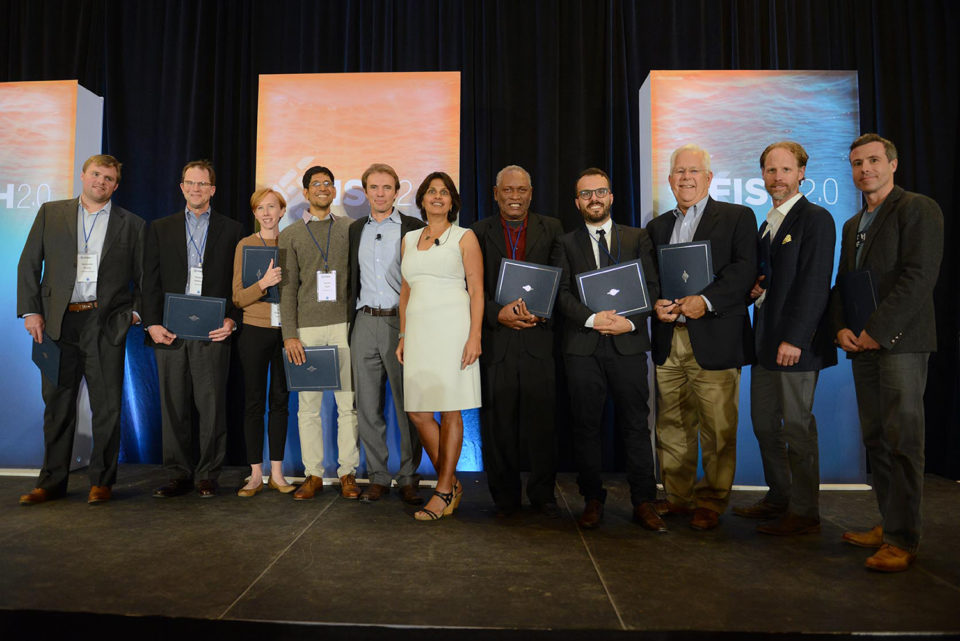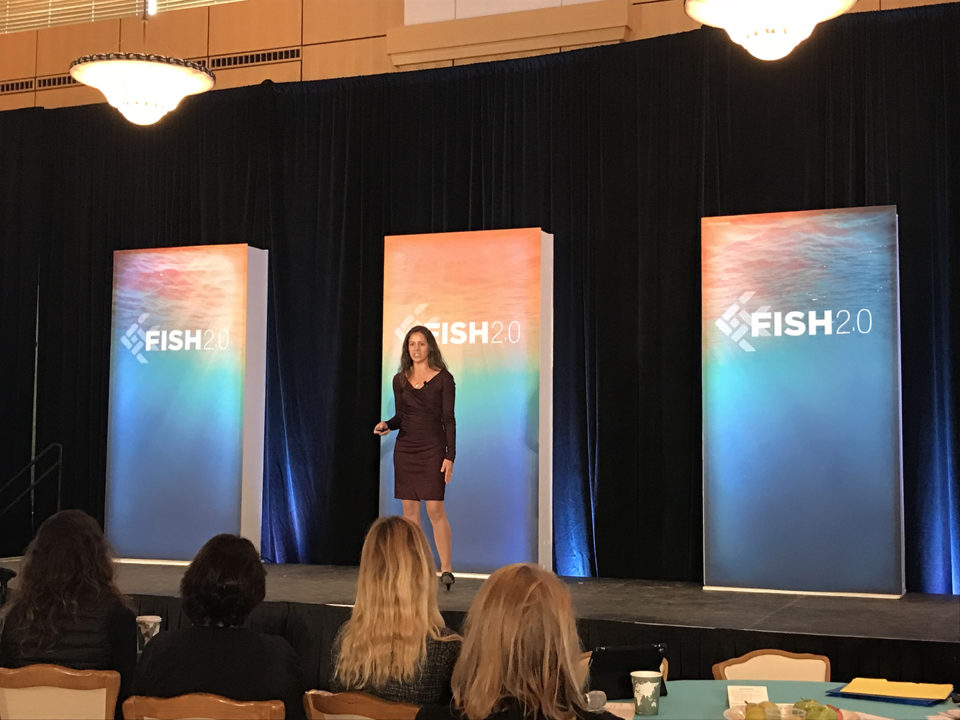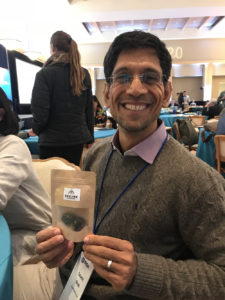Oyster businesses, oral vaccines and a land-based eel farm among the tantalizing seafood investment opportunities

At the Fish 2.0 Innovation Forum last week, a few dozen visionary seafood entrepreneurs cast their lines in a room full of seafood-focused investors, hoping to find one (or more) who could catapult their business to commercialization.
For some, the global connections forged at the event were reward enough. But for others, their dreams took a step forward toward reality.
Held at Stanford University in Palo Alto, Calif., the biannual conference/competition showcased 40 new seafood businesses, or related services, from around the world. Each was represented by a single entrepreneur who had mere moments – some had 90 seconds, others a full three minutes – to win over a panel of expert judges (not to mention a room of 200-plus attendees) evaluating their pitch, their product, their technology, or their business model.
Event Founder and Executive Director Monica Jain, whose team vetted 184 applications – many of which were “investment-ready businesses” – said the record-high interest indicated the fast pace of change throughout the sector.
“Seafood innovation is growing like never before,” said Jain, who said that more than $60 million has been invested into seafood businesses that presented at Fish 2.0 since the event’s launch in 2013. “We can start change, right here in 36 hours, that can last for decades to come.”
Winners were chosen on the strength of the business opportunity (business model, product-to-market fit and go-to-market strategy), meaningful impact and compelling leadership and presentation.
Of the nine eventual winners, five have connections to aquaculture: Panacea Oysters in Crawfordville, Fla., USA; Real Oyster Cult in Duxbury, Mass., USA; EnerGaia in Bangkok, Thailand; NovoNutrients in Sunnyvale, Calif., USA; and American Unagi in Thomaston, Maine, USA.
People want to see this sector grow and change. The momentum for change in seafood has not always been this strong.
Aquaculture provides many avenues for innovation, the expert judges and speakers on three panel discussions agreed. Andrew Beebe, managing director at Obvious Ventures, said aquaculture is a “radical solution” to the challenges facing global food security, with deep parallels to the renewable energy sector.
“There are winners throughout the value chain, from wholesale to consumer,” he said. Aquaculture feeds is a sector that’s particularly ripe for new business opportunities, he added: “It’s right for disruption. We’re optimistic about this space.”
Keeping eels in Maine
Sara Rademaker, CEO of American Unagi, was named via audience polling the winner of the short-pitch contest. Rademaker went to Fish 2.0 seeking investors to grow her business, which aims to raise Maine glass eels to market size – in Maine.
Currently those eels, which are harvested in a tightly regulated fishery worth tens of millions of dollars, are predominantly exported to Asia for grow-out systems there. Why not keep them in Maine, which has a bustling aquaculture community in place, she asked?
Rademaker aims to scale from pilot to commercial in 2018.
Florida needs an oyster hatchery
Two companies pitched the idea of building Florida’s first oyster hatchery, filling a huge need for growers in the panhandle region. Don McMahon, president of Pensacola Bay Oyster Co. in Pensacola, Fla., got 90 seconds for his pitch to put an end to the oyster seed shortage that he said is stymieing the industry’s growth.
But it was Rob Olin, CEO of Panacea Oyster Co-Op Corp. in Spring Creek, Fla., who was named the winner of the USA-Gulf Coast track for shellfish and crustaceans. The co-op – formed by more than 30 “oyster ranchers” in Apalachicola Bay who shared resources and completed an initial fund-raise of $1.385 million – ultimately aims to build a national brand for the “Panacea Pearl.” Olin added that oysters grow faster in the bay than “anywhere else on the planet, just six to nine months!”
Judges remarked that Panacea Oysters’ pitch included a “very important role of training” operators as well as a strong “focus on scalability.”

Not just a following
Capitalizing on the global oyster renaissance, Rob Knecht, CEO and co-founder of Real Oyster Cult, wants to make slurping more convenient for connoisseurs. His farmer-to-consumer online shop, Real Oyster Cult, which the panel of judges deemed to have “high potential for scalability” and a strong branding strategy, is already shipping oysters from farmers direct to consumers in 46 U.S. states. It was named the winner of the New England track.
“Oysters don’t preach sustainability, they practice it,” Knecht said as he stormed the stage, promising to cut out layers of wholesalers and distributors that rob the product of freshness – which is what oyster lovers truly want. “There’s something so visceral about opening an oyster and sharing them with friends and family. Oysters are the new wine – there’s 150 flavor profiles and our customers are geeking out over them.”
Making cities green

EnerGaia won the Mekong-Indonesia track with a creative business model that would see spirulina farming thrive in both rural and urban environments. Think rooftops in big cities like Bangkok, where the company is based.
EnerGaia devised a way to grow the superfood in an innovative seawater production system, that can be expanded on an outsourced-contract basis. Any city property owner, for instance, could enter a lease agreement to grow spirulina using the company’s technology and knowledge, committing 80 percent of its sales back to EnerGaia. “We pay capex, and it’s a low-value stream for them,” said Saumil Shah, managing director. “We keep the harvest and sell it; logistics costs go down.”
The judges remarked that EnerGaia has a “great concept, and is clearly thinking about scale.”
The spirulina, which can be harvested and sold in fresh or in dried form, can be used as a vitamin supplement and as an ingredient in recipes for things like ice cream and hummus. The product is in the process of getting organic certification, and even has potential as an aquaculture feed ingredient.
“We make a functional food product,” said Shah, who brought samples of smoothies, pastas and energy balls to the event, which only strengthened his case. “And we uplift livelihoods in the process.”
An alternative to oral vaccines
Vaccines are a promising alternative to antibiotic use in aquaculture, but administering them to thousands of fish is a major challenge. Promising a cost-effective alternative to injecting individual fish, VakSea pitched its new, patented oral vaccine technology that head of business development Mihir Pershad said could put a dent in the $22 billion in losses the industry suffers each year due to infectious diseases.
“Vaccinating fish by injection: If that sounds ludicrous, it’s because it is,” said Pershad. “You can feed fish a vaccine the same way you feed it food, while cutting out the extra labor. It’s akin to taking a pill instead of a flu shot.”
How VakSea stands out is its process: It grows vaccines in insect larvae, which are then ground up and used in a specialized feed formulation. “Vaccines can have a tremendous impact for high value species like salmon,” said Pershad.
Masters of microbes
With many entrants arriving at Fish 2.0 from faraway nations, NovoNutrients came from nearby Sunnyvale, Calif., and walked away a winner.
The company ferments microbes to convert carbon dioxide from industrial emissions into an aquaculture “superfood” it calls NovoMeal. It is packed with protein, vitamins, essential amino acids and omega-3 fatty acids, said VP of business development Heyward Robinson.
Judges called out NovoNutrients’ “deep scientific knowledge and strong domain expertise” in naming the company the winner of the global track for supply chain innovations.
Fish 2.0 is expanding its reach by extending the selection and screening process on a year-round bases, and will conduct more regional events throughout the year, said Jain. Beyond the whirlwind two days at Stanford, she hopes the event can continue to accelerate change in aquaculture and wild fisheries and remove barriers in the seafood sector by connecting industry to investors.
“This is why Fish 2.0 exists,” said Jain. “People want to see this sector grow and change. The momentum for change in seafood has not always been this strong.”
Author
-

James Wright
Editorial Manager
Global Aquaculture Alliance
Portsmouth, NH, USA
Tagged With
Related Posts

Innovation & Investment
Aquaculture Exchange: Monica Jain, Fish 2.0
The third installment of Fish 2.0, taking place this November, will feature numerous aquaculture-related businesses at various stages of development. The competition’s founder dishes on what the judges will be seeing on stage.

Innovation & Investment
Like fish in a barrel: Seafood innovators land investor interest
At Fish 2.0, it’s seafood, Silicon Valley style. Aquaculture companies gave their best pitches to investors and two left Palo Alto, Calif., as winners. Founder Monica Jain says the competition highlights a financial gap that must be bridged for the industry to advance.

Aquafeeds
Aquaculture Exchange: Rick Barrows
After 14 years with the USDA’s Agricultural Research Service, Rick Barrows talks about the importance of finding ‘complete’ and commercially viable alternative sources of omega-3 fatty acids and continuing innovation in the aquafeed sector.

Innovation & Investment
Aquafeed ingredient AlgaPrime wins GAA Innovation Award
A proliferation of alternative feed ingredients has allowed aquaculture to extend the natural resources it depends on. AlgaPrime, packed with the long-chain omega-3 fatty acid DHA, is being recognized as a game-changing innovation for aquaculture feeds.

